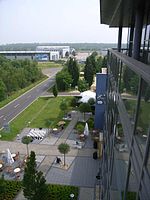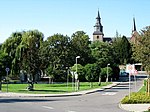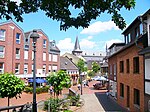Wegberg-Wildenrath Test and Validation Centre
1997 establishments in GermanyRailway test tracks

The Wegberg-Wildenrath Test and Validation Centre (German: Prüf- und Validationscenter Wegberg-Wildenrath) is a railway test centre owned by Siemens near Wildenrath in North Rhine-Westphalia, Germany.
Excerpt from the Wikipedia article Wegberg-Wildenrath Test and Validation Centre (License: CC BY-SA 3.0, Authors, Images).Wegberg-Wildenrath Test and Validation Centre
Friedrich-List-Allee,
Geographical coordinates (GPS) Address Nearby Places Show on map
Geographical coordinates (GPS)
| Latitude | Longitude |
|---|---|
| N 51.115833333333 ° | E 6.2180555555556 ° |
Address
Friedrich-List-Allee 23
41844
North Rhine-Westphalia, Germany
Open on Google Maps










